Pawing the ground with one front hoof is a clear sign of impatience and frustration on the horse’s part. You’ve probably seen the horse that digs himself into a hole when left tied up or bangs a front hoof against the stall impatiently until he’s fed. It’s kind of like a little kid rolling around on the ground at the shopping center because his mother won’t buy him candy. He’s spoiled and having a bit of a tantrum.
Initially, horses paw because they want or need something—they don’t want to stand tied or they want their grain faster! However, once a horse has been allowed to paw over a long period of time (and has been rewarded for his behavior), it often becomes an ingrained habit that no longer has any specific cause. For example, as soon as you tie him up, he immediately starts to paw before you can even turn and walk away from him. Or, as soon as you walk into the barn in the morning, he begins to paw the ground in anticipation of his feed.
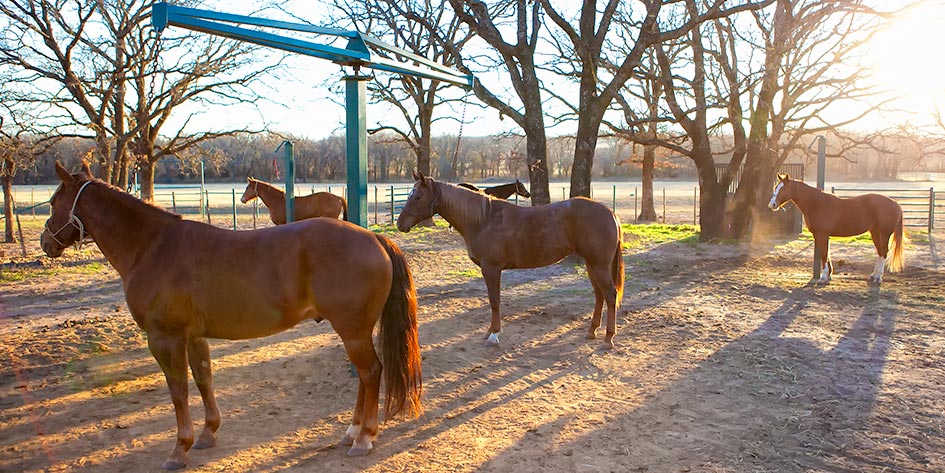
The horses on the ranch spend three to four hours each day tied up to Patience Poles.
Addressing Pawing When Tied Up
A horse that paws when he’s left tied up does so because of a lack of training and patience. The best way to teach a horse to tie up well is to practice tying him up. I tie my horses for at least three to four hours a day, every day, and there are a lot of days that they get tied up all day as well. It doesn’t matter if they’re good, bad or indifferent, they all get tied up. Oftentimes, a horse that paws when tied up does so because he knows he’s going to get attention from you. What usually happens is the horse paws, the owner comes out to stop him or even untie him, he begins to think to himself that he’s controlling their actions and getting them to come to him. Think of your horse like a little kid throwing a fit for attention. Every time he’s rewarded for his behavior, the problem just gets worse. That’s why it’s best to just ignore him when he paws and teach him to stand tied with patience.
Tying a horse up for long periods of time accomplishes many important things in your training. I have a little saying, “End each training session by tying your horse up to the ‘Tree or Post of Knowledge.’” When you tie your horse up after a training session, it teaches him not only respect and patience, but it also gives him a chance to think about and absorb what you have just taught him.
The very last thing you want to do after a training session is get off your horse, take him back to the barn, unsaddle him, hose him off and put him in his stall to eat. This puts his focus more on getting back to the barn and eating than on thinking about his job. If you get into the habit of tying your horse up for two to three hours after you ride him, he won’t be in such a hurry to get back to the barn.
Some people will read that and think that I’m being cruel to the horse. But I have to ask, “What’s the difference between a horse standing still in a stall or a horse standing still on a Patience Pole? The difference to me is that if he’s standing tied to a pole, he could be thinking about you and what you’ve just taught him, but I guarantee you that in the stall he’s not thinking about you at all. (Yes, I know that statement just broke a few hearts.)
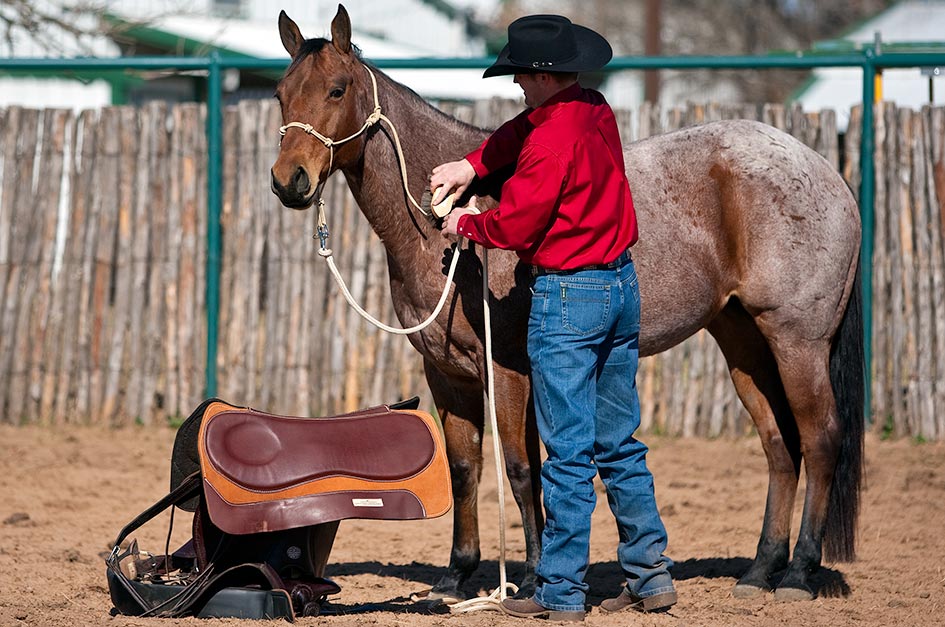
The biggest mistake you can make is putting your horse back in his stall immediately after your training session ends.
Practice = Patience
What happens to most owners who have horses that paw when tied is that they only tie their horses up 10 minutes a day. When they do tie the horse up, he thinks it’s the worst thing in the world and throws a fit. If you want your horse to tie up well, you have to practice and teach him patience. If you practice it every day, it just becomes a natural part of your horse’s routine. It’s no different than anything else you teach him.
Ropers are notorious for having horses that instantly fall asleep when they tie them up because when they go to a roping, they leave the horses tied up to the fence all day long. If you go to a roping you’ll see a hundred horses standing alongside the fence with hind legs cocked, heads lowered and eyes shut sleeping. Why? Because their owners have taught them to stand still and relax while they are tied up. Those horses know that they’re going to be on that fence for a long time. You want your horse to develop the same mentality so that when you tie him up, he immediately relaxes.
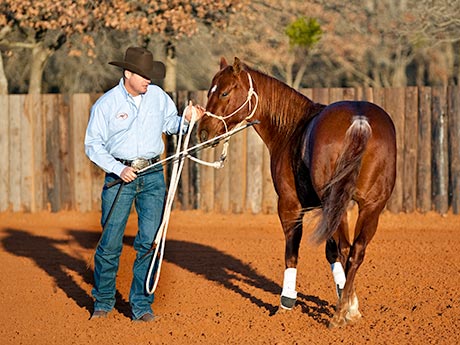
A Horse that Paws Needs More Groundwork.
If your horse paws when you’re around him, it’s a clear sign you need to do more groundwork. For example, if your horse paws when you’re grooming him or saddling him, he doesn’t respect you or have his attention on you, instead, he’s got his mind elsewhere, anticipating being away from you. You need to move his feet forwards, backwards, left and right and always reward the slightest try, and establish yourself as the leader, because right now, your horse isn’t respecting you. A respectful horse stands still when you’re working around him, has his attention on you and doesn’t move until you tell him to.
Addressing Pawing at Feed Time
I’ve actually had personal experience with a horse that developed the habit of pawing at feed time. In the early days of my career, when I was on the road every weekend giving clinics, going to tours and expos, Mindy went along with me and developed this habit. When I’m at a tour or expo, I’m always kind of in a hurry. I have people to see, demonstrations to do and so forth. I’d go see Mindy in the morning, feed her and quickly leave. Sometimes, I didn’t even get to feed her myself. I’d have one of my apprentices feed her. Mindy got into the habit of standing at the stall door and pawing at it to be fed in the morning. Because we were all in a hurry when feeding and didn’t take notice of it right away, Mindy’s pawing just got worse and worse until it became a serious problem.
To fix the problem, if Mindy was standing at the stall door and pawing, wanting her feed quicker, I just didn’t feed her. I fed every other horse in the barn and left her. Of course in the beginning, that made her really upset and she’d paw even more, whinny and act like I was the worst owner in the world. But I just left her there. When she finally stopped pawing, maybe an hour or two later, I’d put the grain in her bin, rub her on the neck and walk out of the stall. I would only feed her once she completely relaxed and wasn’t thinking about feed.
What I noticed was when I finally did feed her, it was like a surprise, “I thought you forgot about me Clinton. Thank you very much!” And I noticed how much more expressive she was about being fed. It was almost like she was thankful or grateful that I was feeding her. Previously, her attitude, when she was pawing at the door, was a bit bossy. Like, “Come on. You know I’m the greatest superstar in the world. You need to feed me now!” kind of deal.
It wasn’t easy to break Mindy of her habit—this routine went on for about five days in a row until I eventually got her to stand quietly during feeding time. At the end of that first week, when I went to feed the horses, I noticed she didn’t even think she was going to get fed. She had her head in the stall corner, hind leg cocked and was sleeping. Before, as soon as she heard me rattling around the scoops, she was banging the stall bars like a prisoner. Now, it was almost like she wasn’t interested and could care less about it.
So how did I stop Mindy’s behavior? By no longer rewarding it. Because I was in a hurry, I was rewarding her bad behavior by throwing her feed when she was pawing. She in turn thought that pawing would get her feed faster. Once I stopped rewarding her behavior, and made her wait until she was no longer pawing, she soon learned not to get excited. I will admit that it wasn’t always easy for me to go back at a later time and feed her, especially in the evenings. However, oftentimes with horses, the most convenient thing is not always the thing that will fix the problem. In fact, it never is!
Not Just an Annoying Habit.
While some horses paw the air without actually touching the ground, many horses put a lot of energy behind pawing and really make a racket. When the horse aggressively digs the ground, he not only damages the area around tie posts and stall floors, but can unbalance his hooves, tear off shoes and damage his joints from repeated concussion. In fact, pawing is easily one of the top reasons why horses lose shoes. From repeated pounding, the shoe either loosens or catches on something like a fence and pulls off, which is all the more reason why you need to address your horse’s habit.
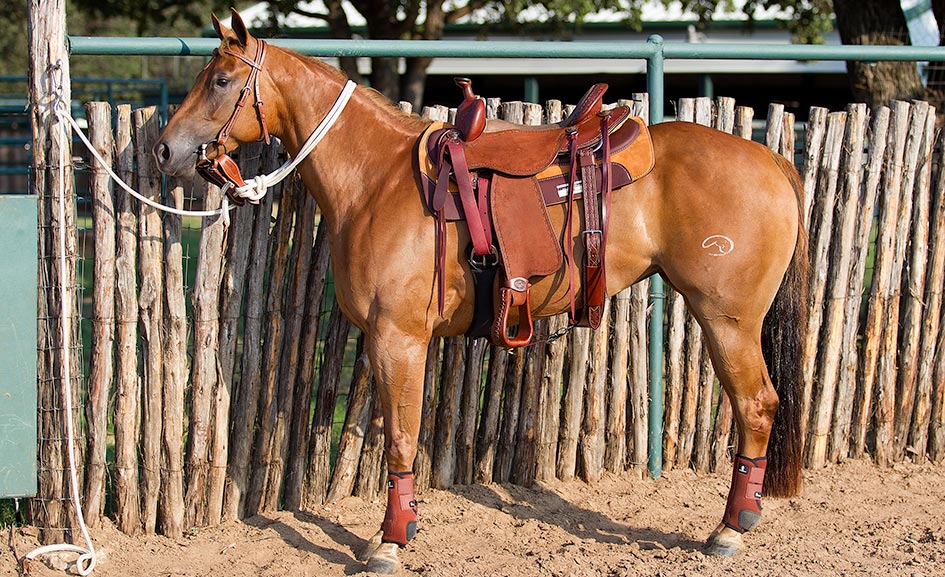
You want your horse to develop the mentality that when you tie him up, he should immediately relax and fall asleep.
Mix Up the Schedule
One of the worst things you can do with horses is feed them at the same time every day because the trouble with horses is they quickly fall into a routine and become programmed. If you always feed at 5 o’clock, if you’re not out in the barn at 5, by 5:01, they’re all going to be banging down stall doors, chewing the wood, running around and kicking up their heels. If horses are fed at different times each day, they never know when the food is coming, so they never get a chance to build up that anticipation. So one of the best things you can do is mix up your schedule to keep your horses from expecting their feed at a certain time each day.
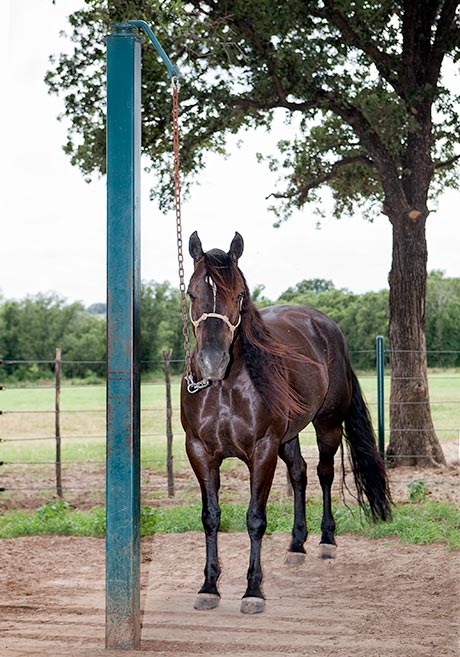
Make the Horse Feel Uncomfortable for Pawing.
One way you can deter pawing and save your facility from being filled with holes is by making it uncomfortable for the horse to do so. Around your Patience Pole, or wherever you tie your horse, put a small concrete pad, wooden slats or lay down strips of rubber conveyor belt. That way the horse can paw all day, and he won’t dig a gigantic hole in the ground. If the horse is barefoot and he paws, eventually the pawing will start to shorten up his hoof and the hoof will begin to hurt a little bit. Before long, he’ll be making himself feel uncomfortable for pawing.
Keep in mind though that the main reason horses paw is because they have a lack of patience. If you practice tying your horse up and let him get used to being tied until he learns to fall asleep, soon pawing won’t be an issue. In most cases, if you’re consistent about only untying the horse when he’s relaxed and not pawing, he’ll learn within a day or two to stop pawing.

Want To Learn More? SIGN UP FOR OUR LOYALTY PROGRAM
Master your horsemanship training through Clinton’s step-by-step method videos by joining the No Worries Club today. Becoming a club member ensures you get VIP pricing on all of Clinton’s must-have training tools and resources. Plus, you’ll enjoy all the phenomenal benefits that come with club membership!



